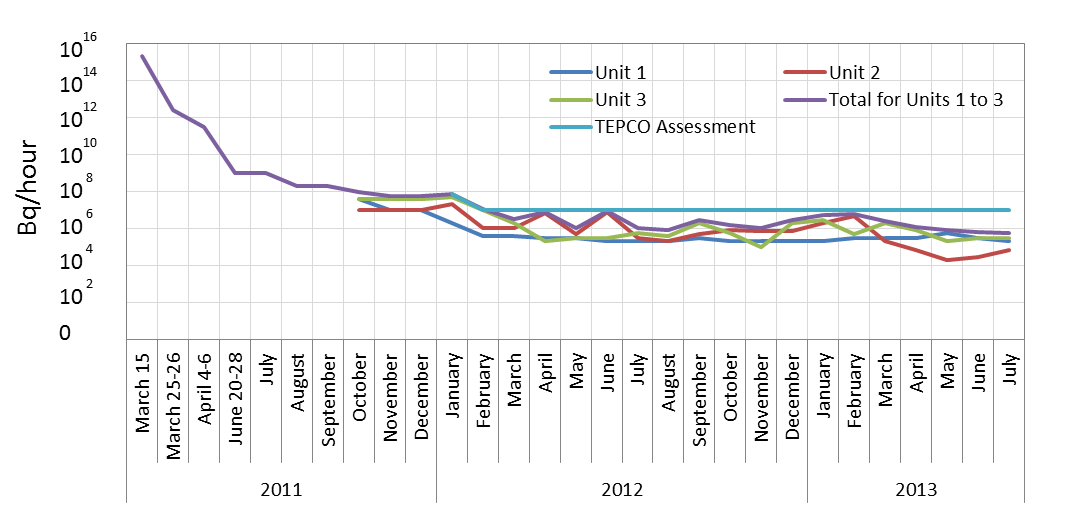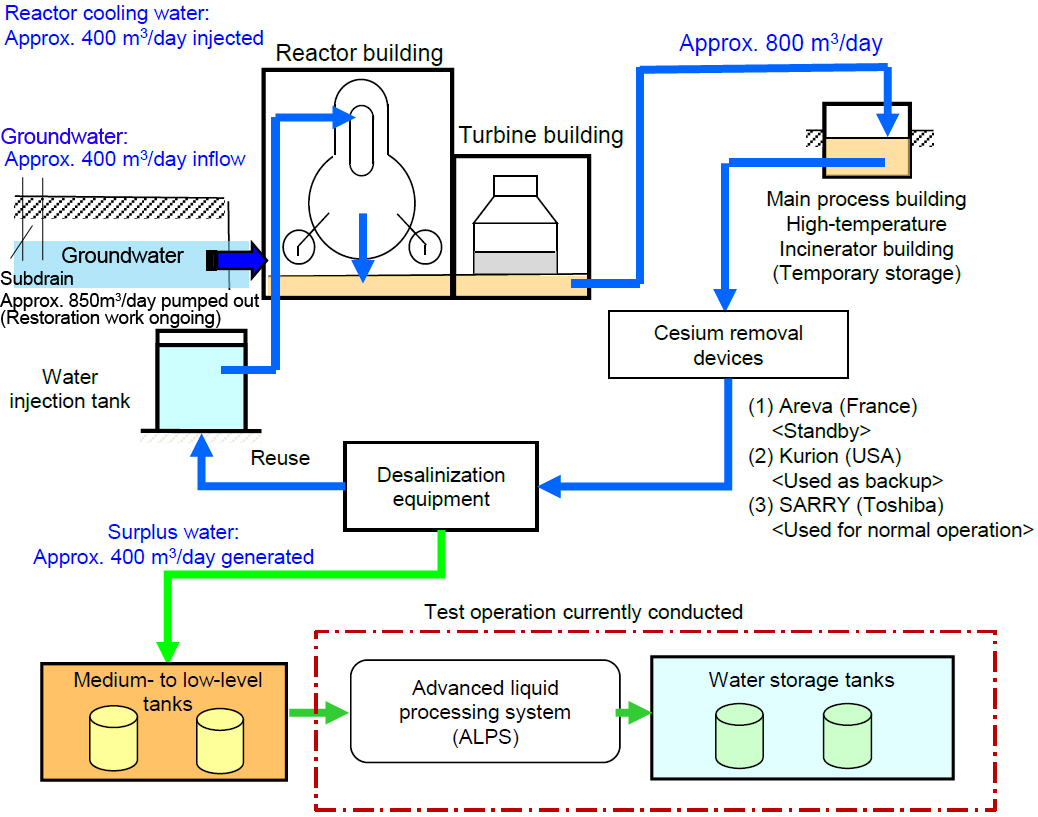Situation at the Plant
 |
|
Figure 1; Releases of radioactivity from
Units 1 to 3 of Fukushima Daiichi Nuclear Power Station
From materials prepared and submitted by the
secretariat to the Government and TEPCO’s Mid-to-Long Term
Countermeasure Meeting and Secretariat of the Council for the
Decommissioning of TEPCO’s Fukushima Daiichi Nuclear Power Station.
(However, this was for assessing leakage from exhaust outlets and gaps
in building covers and does not include leakage to groundwater, etc.)
|
Many of the instruments in the measuring systems at
the Fukushima Daiichi Nuclear Power Station (FDNPS) suffered breakdowns
due to the accident. There is doubt about the accuracy of the values
being currently measured, but taking these values as a premise it is
possible to estimate from the containment temperature and releases of
Xenon-135 gas that the reactors are stable. Even now, however,
radioactive materials are continually being released and the situation
does not allow for much optimism (Figure 1).
Post-accident Cleanup Process
1. Molten Nuclear Fuel
Decommissioning work is progressing on the basis of
the “Mid-and-Long-Term Roadmap towards the Decommissioning of TEPCO’s
Fukushima Daiichi Nuclear Power Station Units 1-4” drawn up by the
government and TEPCO on December 21, 2011 (amended on July 30, 2012 and
June 27, 2013. Hereafter known as the “Roadmap”).
The Roadmap indicates that the plan for removing the
molten nuclear fuel will be implemented in approximately the following
nine stages.
1. Decontamination of reactor buildings,
2. Inspection of the lower part of the containment,
3. Waterproofing of the lower part of the containment and the reactor
building,
4. Partial filling of the containment with water,
5. Inspection and sampling of the interior of the containment,
6. Repair of the upper part of the containment,
7. Filling of the containment and reactor pressure vessel with water,
8. Opening of the upper lid of the reactor pressure vessel and
inspection of the interior of the reactor,
9. Removal of the molten nuclear fuels.
At present, inspections are being implemented for
all units to confirm the status of each of them in the moves toward the
decontamination of the buildings and to determine the locations of
leaks in the containments.
2. Spent Nuclear Fuel
The Roadmap states that the spent nuclear fuel
removal plan will be implemented approximately according to the
following stages.
1. Removal of rubble and wreckage,
2. Construction of covers and cranes,
3. Design and manufacture of transport containers and canisters,
4. Securing of capacity in the common pool and remodelling of
equipment,
5. Removal, storage and management, and transport away from site of the
spent nuclear fuel in the cooling pools.
By December 2012, Stage 1 had been completed at Unit
4. At present the construction for Stage 2 is in progress and Stage 5
is scheduled to begin in November 2013. Stage 1 is progressing at Unit
3, and the measures for reducing radiation are due to be implemented on
the operating floor, the fifth floor of the reactor building, before
long. In order to carry out the work for Stage 1 in Unit 1 in mid-2013,
initiation of work to demolish the current reactor building cover has
been scheduled, but there is concern over increased releases of
radioactive substances after the demolition. For Unit 2, high radiation
has made it impossible to confirm the situation in the interior of the
building.
Several problems exist in the eventual removal of
the spent nuclear fuel. For example, concerns over the possibility of
corrosion by seawater and damage due to wreckage, the possibility of
accidents due to falling fuel during removal, and damaged fuel that has
been in the spent fuel pool for some time, even since before the
accident.
3. The Problem of
Contaminated Water
 |
Figure 2; Diagram of current water regime at Fukushima Daiichi Nuclear Power Station
TEPCO Fukushima
Daiichi Nuclear Power Station, June 27, 2013, Mid-and-Long-Term Roadmap
towards the Decommissioning of TEPCO’s Fukushima Daiichi Nuclear Power
Station Units 1-4, figure on p.40 partially amended |
At FDNPS, in order to prevent the plant buildings
rising due to seepage of groundwater and rising of the water table,
roughly 850 m3/day of water was being pumped out of the subdrains (pump
wells) of Units 1 to 4 and allowed to flow into the ocean.
Following the accident, the subdrains became
unusable and the water table has risen. According to an estimate by
TEPCO, approximately 800 m3/day are flowing into the buildings. All 400
m3 of groundwater flowing into the reactor buildings, if TEPCO
estimates are correct, is being treated as contaminated water (see
Figure 2). Part of the remaining 400 m3 is coming into contact with the
highly radioactive contaminated water that has accumulated in the many
trenches (underground conduits for pipes and electrical cables) onsite
and is currently flowing out into the ocean. There is also the
possibility that this highly radioactive contaminated water is leaking
into the surrounding soil through the bottom of the trenches.
The Roadmap shows the following as countermeasures
for groundwater problems.
1. On the upper inland side of the plant, a “groundwater bypass” has
been constructed to pump up groundwater and release it into the sea in
order to lower the water table and reduce the amount of water flowing
into the reactor buildings. (The construction is complete, but the
consent of local people has not been obtained and the bypass is
therefore not in operation.)
2. Restoration of the subdrains for management of the water table
(scheduled to be operational in mid-2014).
3. Construction of an inland frozen earth water barrier (an ice barrier
created by burying refrigeration pipes at set intervals around Units 1
to 4 – scheduled to begin operation in the first half of FY2015).
4. Preventing the draining of water from the buildings of Units 1 to 4
through the (roughly 880) holes, etc. in the outer walls of the
buildings.
5. Reduction of soluble content of contaminated water using the
Advanced Liquid Processing System (ALPS) to separate other nuclides
from the "treated water" still containing Tritium* (scheduled to be
fully operational in mid-2013),
6. There are plans to increase the number of tanks and so on, and an
ocean-side water barrier is scheduled to be constructed by September
2014 as a countermeasure against groundwater outflow into the ocean.
The Roadmap also states that holding capacity for
contaminated water will be approximately 800,000 m3 in January 2021,
following which a state of equilibrium will be reached. The premises
for this, however, are that water from the ground water bypass and
water pumped out from the subdrains is released into the ocean and that
all the other measures are successful. In addition, TEPCO also
considers that release of the Tritium-containing water arising from 5.
into the ocean is one possible option.
Please also see the article on p.1 for more
information on the many contaminated water leakage problems that are
occurring in the meantime.
(Hajime MATSUKUBO, CNIC)
* Releases weak
beta-particles (max. 18.6, average 5.7keV) and no gamma radiation.
Often said to have little impact on the human body, but caution is
necessary. If Tritium-containing water taken into the human body
replaces hydrogen atoms that make up DNA, there is a risk of
beta-particles damaging surrounding genes. Genetic disorders, neonatal
deaths and infant leukemia have been reported in Canada.
Return to CNIC's
Earthquakes and
Nuclear Power page
Return to NIT 156 contents

